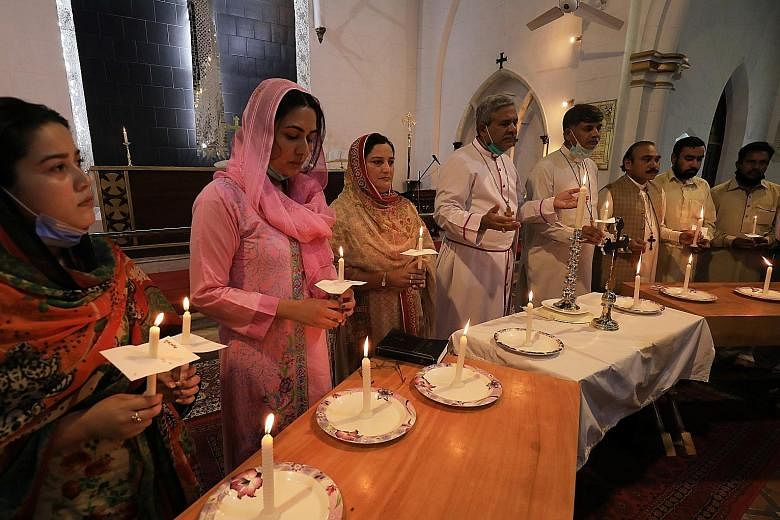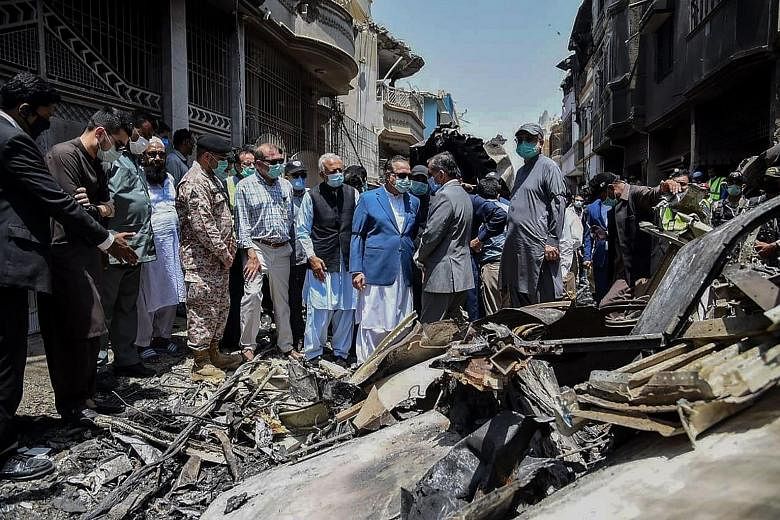KARACHI • It was supposed to be another regular flight on one of Pakistan's busiest domestic routes between its two biggest cities.
State-run Pakistan International Airlines' Flight PK8303 had a normal departure from the eastern city of Lahore. Close to landing in Karachi before 2.45pm local time, the pilots told passengers to fasten their seat-belts as it approached the city's airport in a flight that usually takes less than two hours. Everything was fine - until the last few seconds.
The plane began its descent. But instead of gliding on the runway, it hit the ground a few times - for about 20 to 30 seconds - before the pilots pulled the plane back up into the air again. It reached an altitude of 968m about two minutes later, based on data by FWIW, the Flightradar24 website that tracks aircraft.
The pilots added power and lifted off again, a manoeuvre known as a go-around. While a witness said it was aloft for 10 to 15 minutes longer, Flightradar24 data indicated the plane was nearing the ground 5½ minutes later.
It was in that window that the pilots announced a second attempt to land. Calls for help were heard at the airport control tower.
"Sir, we have lost engines," one of the pilots said to a controller, according to a recording from LiveATC.net, which collects audio feeds from air-traffic staff. About 30 seconds later, the pilot again radioed a distress call: "Mayday. Mayday. Mayday."
On the last recorded position captured by a Flightradar24 ground station, the Airbus SE A-320 jet was at an altitude of about 152m and descending. The plane, carrying 99 people, smashed through rooftops of houses before crashing into a narrow lane of a residential area just kilometres from the airport.
"After the crash, there was fire everywhere, you could not see anyone," said Mr Muhammad Zubair, a survivor from the plane crash that killed 97 people. "I released my seatbelt, and headed towards the light."
Mr Zubair recounted the final moments of the flight before the accident to a local television channel. He was seated in the eighth row while the other survivor, Bank of Punjab president Zafar Masud, was seated in the first row, local news outlets reported.
Rescue workers recovered bodies as smoke gathered in the area. Some bodies had oxygen masks on, indicating that an emergency was declared while the plane was in the air, according to Pakistani rescue agency Edhi.
Edhi was first alerted by witnesses, and said there could have been more survivors if it had received the call to be on standby the minute the aircraft reported a problem, a practice followed in the past.
The crash spread chaos throughout the city that had already seen its healthcare system choked up by the coronavirus outbreak.
The first few bodies brought in from the crash site could be identified by families.
"But after 15 to 20 ambulances, the condition got worse, it became very painful to see," said Mr Usama Qureshi, co-founder of engineering firm Bolts, who had hoped to find the more than half a dozen people he knew to be on the flight.
"The families who have lost lives want to know what happened," Pakistan's Aviation Minister Ghulam Sarwar Khan said in a press briefing in Karachi last Saturday. "We will make the report public as soon as possible."
Pakistan has set up a four-member panel, which will submit its report on the disaster in three months, Mr Khan said.
The authorities have found the plane's flight data recorder, but the search for the cockpit voice recorder is ongoing.
Pakistan International's chief executive Arshad Malik said that the aircraft, which first entered service in 2004, had passed all tests before the flight and underwent a major check in March.
The pilot had reported a "technical fault" before deciding to go around instead of landing, he said.
This is the second plane crash for the state-owned carrier in less than four years. In late 2016, the crash of an ATR 42 turboprop killed 47 people. The airline, founded in 1946, suffered as many as 51 safety-related incidents before last Friday's crash, according to data from Aviation Safety Network.
BLOOMBERG


